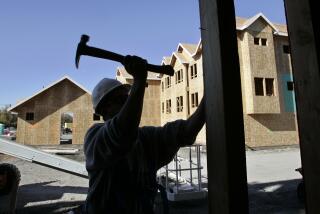Opinion: Brown’s affordability fix is fine. But California needs all the housing it can get — including in its suburbs
- Share via
Gov. Jerry Brown’s recent proposal designed to streamline the development of affordable housing in California is a welcome step in the right direction for a state that seems to be engaged in a dangerous experiment in seeing how long you can do nothing about housing and get away with it.
Let’s be very clear about the problem here. California needs a huge amount of new housing to curb what has become an epic housing affordability crisis in the Golden State – one that’s particularly acute in and around Los Angeles. How bad is it? Renters in the L.A. metro are paying 48% of their monthly income on the area’s median rent, up from 36% historically. Almost half (48.7%) of working-age adults in Los Angeles County are doubled up with one another in housing units – up almost 10 percentage points since 2000. It’s even worse in the Inland Empire: Roughly 45% of working-age adults in the Riverside/San Bernardino areas live with another adult, up 15 percentage points since 2000. And the less affluent are losing ground (literally) statewide. The typical commuting distance for lower-income workers in downtown San Francisco has almost doubled since 2009.
There’s been no change for higher-income workers.
Two factors play a critical role in this crisis. First, income growth has been weak or virtually nonexistent for years for middle- and low-income residents – and has even gone down slightly in the L.A. area in real terms. Second, the pace of construction of new housing units — affordable and market-rate — has been dwarfed by the number of new residents drawn to the state by its strong economy. While anemic income growth isn’t good, this lack of housing supply is a much larger contributor to the broader affordability problem. It’s also the easier of the two problems to solve. Large-scale new housing development, even in California, isn’t impossible. But the state has largely been unwilling or unable to tackle the difficult political issues that housing policy fights often bring that slow down or derail new development.
In this context, Brown’s proposal works. It directly addresses a key affordable housing challenge: how to build low-cost housing in high-cost areas. Brown has recognized that while there’s little government can do about fixed development costs – it can’t set the price of land, labor or lumber – there’s a lot it can do to lower regulatory costs (proven to drive up rents and drive down inventory) and cut down on the time it takes to get shovels in the ground. Allowing affordable housing developments to bypass California’s complicated CEQA environmental impact rules and sidestep some neighborhood review processes balances the competing interests of the collective need for more housing with individual concerns, and doesn’t cost taxpayers a dime.
But, while this proposal is a great start, it won’t make much of a dent in the bigger problem of insufficient housing overall.
In many areas of the state, a tried-and-true source of new housing for suburban and smaller urban communities is larger, single-family tract housing developments on open land at the periphery of town, which would not be eligible for expedited approval under this proposal. This kind of development raises a host of concerns around sprawl and environmental impact, especially in L.A., and any new development should be smart, with transit at its core. That’s not always easy to do, but the alternative – building more density in the downtown core – is often shot down by entrenched neighborhood interests before it sees the light of day. And in either case, this proposal on its own doesn’t do enough to alleviate the problem. California is growing too fast, and there is only so much land to build on in its already crowded urban cores.
California needs to take a hard, honest look at overhauling CEQA rules not just for affordable housing developers, but all housing development. Passage of California Senate Bill 1069, which would loosen restrictions on so-called “granny flats” and increase the housing supply, is a crucial next step. We need to embrace robust regional housing planning as a means of overcoming NIMBYism, and/or more regional transportation planning in order to efficiently move people from areas with more affordable housing to areas with more abundant jobs.
California’s housing affordability woes don’t just impact the state’s low- and middle-income residents. Even Silicon Valley’s highly paid tech workers are beginning to encounter challenges finding reasonable affordable housing, putting California at a marked disadvantage compared to cheaper but no-less-desirable states like Washington or Colorado.
This issue isn’t just academically interesting for us. We’re leaders of a tech company with a large presence in California. We often hear from employees about the strain caused trying to find affordable housing, and we do factor these costs into our decisions on where to expand. The longer the problem persists and gets worse, the more California’s hard-won competitive advantages erode.
The housing crisis is much larger than can be solved with a bit more affordable housing. And it demands a bigger solution than simply cutting some red tape. Brown’s proposal is an important and welcome step, but is hopefully just the first of many.
Spencer Rascoff is chief executive of Zillow Group and Dr. Stan Humphries is Zillow Group’s chief economist. They are the co-authors of “Zillow Talk: Rewriting the Rules of Real Estate.”
Follow the Opinion section on Twitter @latimesopinion or Facebook
More to Read
A cure for the common opinion
Get thought-provoking perspectives with our weekly newsletter.
You may occasionally receive promotional content from the Los Angeles Times.










